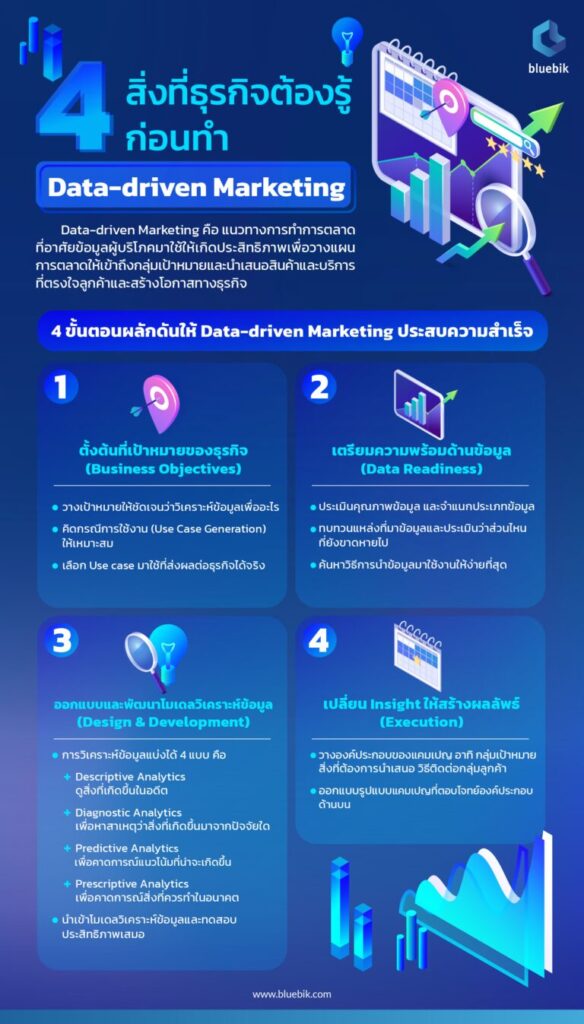ในโลกธุรกิจยุคใหม่ หลาย ๆ คนต่างบอกว่า ควรทำการตลาดที่ขับเคลื่อนด้วยข้อมูล (Data-Driven Marketing) เพราะข้อมูลคือสิ่งที่ทำให้เราเข้าใจลูกค้าได้ดี สามารถค้นหาความชอบและความต้องการของลูกค้าได้อย่างชัดเจนขึ้น และทำให้ลูกค้าเลือกใช้สินค้าและบริการของเราอย่างต่อเนื่องในระยะยาว แต่คำถามคือหากธุรกิจจะเริ่มทำการตลาดแบบขับเคลื่อนด้วยข้อมูล ควรจะเริ่มต้นอย่างไร
ในปัจจุบันธุรกิจทั่วโลกหันมาให้ความสำคัญและเน้นลงทุน ในด้านการจัดเก็บและการวิเคราะห์ข้อมูล เพื่อปลดล็อกข้อจำกัดและเพิ่มศักยภาพการเติบโต เพื่อสร้างผลกำไร โดยการทำ Data-Driven Marketing ถือเป็นเครื่องมือ[]การตลาดหนึ่งที่จะช่วยเสนอสินค้าและบริการให้กับลูกค้า เพื่อตอบโจทย์ความต้องการได้อย่างตรงใจ

4 ข้อควรรู้ก่อนทำ Data-Driven Marketing ให้ประสบความสำเร็จและสร้างผลลัพธ์ได้จริง
การทำ Data Driven Marketing จึงเกี่ยวข้องกับกระบวนการในการจัดเก็บ วิเคราะห์และสังเคราะห์ข้อมูล เพื่อที่จะสามารถเข้าใจในความต้องการของลูกค้าได้ในทุกมิติ ฉะนั้นก่อนที่นักการตลาดจะเริ่มลงมือปฏิบัติ เพื่อผลักดันให้ Data-Driven Marketing ประสบความสำเร็จและสร้างผลลัพธ์ได้จริง จึงควรรู้และเข้าใจใน 4 สิ่งนี้ ได้แก่
1. เป้าหมายของธุรกิจ (Business Objectives)
ธุรกิจหรือนักการตลาดควรวางเป้าหมายให้ชัดเจนว่า ต้องการนำผลลัพธ์จากการวิเคราะห์ข้อมูลไปใช้เพื่อเป้าหมายอะไร เช่น ต้องการขยายฐานลูกค้าให้ได้ 1 ล้านคน ภายใน 3 ปี การตั้งเป้าหมายที่ชัดเจน คือ สิ่งสำคัญลำดับแรกที่จะช่วยกำหนดความสำเร็จในการทำ Data-Driven Marketing โดยกำหนดขอบเขตของการวิเคราะห์ข้อมูลว่า ควรเข้าไปดำเนินการตรงจุดไหน ธุรกิจจึงจะบรรลุเป้าหมายที่วางไว้
เมื่อเป้าหมายของธุรกิจชัดเจนแล้ว ขั้นตอนต่อไปเป็นการคิดกรณีการใช้งาน (Use Case Generation) ซึ่งมีความแตกต่างกันไปตามประเภทธุรกิจ และปัจจัยแวดล้อมในการทำธุรกิจ รวมถึงต้องเลือกกรณีการใช้งานให้เหมาะสมกับเป้าหมายของธุรกิจ ดังตัวอย่างกรณีการใช้งานต่อไปนี้
- เป้าหมายมุ่งไปที่การเพิ่มประสิทธิภาพการดำเนินงานของธุรกิจเป็นหลัก โดยการกระตุ้นให้ลูกค้ากลับมาซื้อสินค้าและบริการเป็นประจำ เพื่อรักษารายได้ เช่น การแนะนำสินค้าอื่นที่เกี่ยวข้อง (Cross-Selling) เพื่อเพิ่มรายได้ที่มากขึ้นกว่าการซื้อสินค้าเพียงชิ้นเดียว หรือการแนะนำสินค้าหรือบริการที่ตรงกับความสนใจของลูกค้าแต่ละราย ในช่วงเวลาที่เหมาะสม (Personalized Promotions/Products) เป็นต้น
- เป้าหมายที่เน้นการพัฒนาประสบการณ์ของลูกค้าเป็นหลัก โดยให้ลูกค้าได้รับประสบการณ์การที่ดีและรักษาให้ลูกค้าซื้อสินค้าและบริการอย่างต่อเนื่อง เช่น การจัดกลุ่มลูกค้า (Customer Segmentation) การคำนวณมูลค่าการซื้อสินค้าและบริการตลอดอายุของการเป็นลูกค้า (Customer Lifetime Value) เพื่อใช้พิจารณาการให้สิทธิพิเศษกับกลุ่มลูกค้าที่สร้างรายได้สูงให้กับบริษัท เป็นต้น
หลังจากคิด Use Case เบื้องต้นได้แล้ว คำถามต่อมาคือธุรกิจจะรู้ได้อย่างไรว่า ควรทำ Use Case ใดที่จะช่วยสร้างผลลัพธ์ทางธุรกิจได้จริง ดังนั้นจึงต้องมีขั้นตอนที่เรียกว่า การประเมินและเลือก Use Case ที่เหมาะสม (Use Case Prioritization) ซึ่งสามารถแบ่งการประเมินเป็น 2 แกน ได้แก่
- ผลลัพธ์ที่ส่งผลต่อธุรกิจ (Business Impact) เช่น การสร้างผลลัพธ์ทางการเงิน การเพิ่มโอกาสทางธุรกิจผลตอบแทนจากการลงทุน (ROI) และความเหมาะสมสอดคล้องไปกับกลยุทธ์องค์กรในภาพรวม
- ความพร้อมของธุรกิจ (Feasibility) เช่น ความพร้อมด้านข้อมูล ความพร้อมด้านระบบหรือกระบวนการทำงาน รวมไปถึงปัจจัยภายนอก เช่น PDPA กฎหมายและกฎระเบียบต่าง ๆ
2. ความพร้อมด้านข้อมูล (Data Readiness)
แน่นอนว่า หากต้องการทำการตลาดที่ขับเคลื่อนด้วยข้อมูล สิ่งสำคัญที่สุดก็คือข้อมูล ดังนั้นธุรกิจจึงต้องสำรวจและประเมินข้อมูลต่าง ๆ ในองค์กรว่า คุณภาพของข้อมูลเป็นอย่างไร มีข้อมูลเพียงพอต่อการนำไปวิเคราะห์หรือไม่ และมีข้อมูลประเภทไหนบ้าง ในปัจจุบันข้อมูลมีรูปแบบที่หลากหลายกว่าในอดีต ซึ่งคร่าว ๆ สามารถแบ่งประเภทข้อมูลออกเป็น 3 แบบ คือ
- ข้อมูลที่ไม่มีโครงสร้าง (Unstructured Data) เช่น รูปภาพ วิดีโอ ไฟล์เสียง
- ข้อมูลกึ่งโครงสร้าง (Semi-Structured Data) เช่น ไฟล์รูปแบบ XML (Extensible Markup Language)
- ข้อมูลที่มีโครงสร้าง (Structured Data) เช่น ตารางข้อมูลในฐานข้อมูล
ฉะนั้น การนำข้อมูลมาออกแบบ Use Case จะช่วยสร้างความได้เปรียบของธุรกิจได้จริง ธุรกิจจึงควรย้อนมาดูช่องทางในการได้มาซึ่งข้อมูลว่า มีการรวบรวมข้อมูลมาอย่างไร จากแหล่งไหน ส่วนไหนที่ยังขาดหายไป และจะนำข้อมูลนั้นมาใช้งานด้วยวิธีใด เช่น การเก็บข้อมูลพฤติกรรมของลูกค้า โดยใช้หลักการเกมมาทำแคมเปญ (Gamification Campaign) เพื่อสร้างปฏิสัมพันธ์กับลูกค้า
หรือการเพิ่มการใช้งานระบบ CRM เพื่อช่วยในการรวบรวมข้อมูลลูกค้าได้อย่างมีประสิทธิภาพ หรือการนำ Centralized Data Lake/Data Warehouse มาช่วยในการเก็บรวบรวมข้อมูลจากแหล่งข้อมูลหลายแหล่ง เป็นต้น

3. การออกแบบและพัฒนาโมเดลวิเคราะห์ข้อมูล (Design & Development)
ก่อนเริ่มออกแบบโมเดลวิเคราะห์ข้อมูล ธุรกิจควรดูก่อนว่าต้องการรู้อะไร และรู้ไปทำไม เพื่อเลือกรูปแบบการวิเคราะห์ข้อมูลที่เหมาะสม เบื้องต้นสามารถแบ่งการวิเคราะห์ข้อมูลออกเป็น 4 รูปแบบ ได้แก่
- การวิเคราะห์แบบพื้นฐาน (Descriptive Analytics) เป็นการวิเคราะห์สิ่งที่เกิดขึ้นในอดีต เช่น ข้อมูลยอดขาย พฤติกรรมลูกค้าที่เคยซื้อสินค้า เป็นต้น
- การวิเคราะห์แบบวินิจฉัย (Diagnostic Analytics) เป็นการค้นหาสาเหตุว่าสิ่งที่เกิดขึ้นนั้นเกิดจากปัจจัยใด โดยวิเคราะห์เชิงหาความสัมพันธ์ (Correlation Analysis) เช่น ยอดขายขึ้นเพราะอะไร ขึ้นเพราะการออกแคมเปญโปรโมชันหรือไม่
- การวิเคราะห์แบบพยากรณ์ (Predictive Analytics) การคาดการณ์แนวโน้มที่น่าจะเกิดขึ้นในอนาคต ด้วยการวิเคราะห์ข้อมูลจากในอดีต
- การวิเคราะห์แบบให้คำแนะนำ (Prescriptive Analytics) เป็นการวิเคราะห์เพื่อคาดการณ์สิ่งที่ควรจะทำในอนาคต
สำหรับขั้นตอนการพัฒนาโมเดลวิเคราะห์ข้อมูล ควรดำเนินการหลังธุรกิจมีเป้าหมายที่ชัดเจน เลือก Use Case และเตรียมข้อมูลที่จำเป็นต่าง ๆ ไว้พร้อมแล้ว โดยขั้นตอนการพัฒนาโมเดลแบ่งเป็น
- การสร้าง Feature เพื่อใช้ในกระบวนการวิเคราะห์ข้อมูล (Feature Engineering)
- การนำ Feature ที่สร้างขึ้นมาเข้าขั้นตอนการเรียนรู้ (Model Training) เพื่อหารูปแบบ (Pattern) ของข้อมูลให้ได้มาซึ่งข้อมูลเชิงลึก (Insight) ที่สามารถนำไปต่อยอดและปรับใช้ในทางธุรกิจได้
- การประเมินประสิทธิภาพของโมเดล (ModelEvaluation) ผ่านการทดสอบต่าง ๆ เช่น Confusion Matrix, F1 Score, AUC – ROC
- การปรับค่าพารามิเตอร์ เพื่อเพิ่มประสิทธิภาพของโมเดล (Model Optimization)
4. การเปลี่ยนข้อมูลเชิงลึกเป็นผลลัพธ์ทางธุรกิจ (Execution)
อีกขั้นตอนสำคัญ เมื่อได้รับข้อมูลที่ต้องการจากการวิเคราะห์แล้ว จะทำอย่างไรให้สามารถเปลี่ยนข้อมูลเชิงลึก (Insight) เหล่านั้น เป็นผลลัพธ์ทางธุรกิจได้จริง
ก่อนออกแบบแคมเปญการตลาด ธุรกิจควรวางองค์ประกอบคร่าว ๆ ของแคมเปญ เช่น ใครคือกลุ่มลูกค้าเป้าหมาย ต้องการนำเสนออะไรให้ลูกค้า และธุรกิจจะติดต่อกับกลุ่มลูกค้าได้อย่างไร หลังจากนั้นนำข้อมูลเชิงลึก (Insight) ที่ได้มา ออกแบบรูปแบบแคมเปญ โดยมีแนวทางเบื้องต้นที่สามารถนำไปปรับใช้ได้ ได้แก่
- การดึงดูดกลุ่มลูกค้าเป้าหมาย เช่น พฤติกรรมการซื้อสินค้าของลูกค้าแต่ละกลุ่ม ที่ได้จากการวิเคราะห์จัดกลุ่มลูกค้า (Customer Segmentation) รวมกับการคาดการณ์รายได้ที่ธุรกิจจะได้รับ ตลอดช่วงการซื้อสินค้าและบริการของลูกค้าแต่ละราย (CLV) เพื่อดูว่าเราควรทำแคมเปญสำหรับลูกค้ากลุ่มไหนเป็นพิเศษ โดยลูกค้าที่มี CLV สูง อาจจะเน้นการส่งข่าวสารโปรโมชันให้อย่างสม่ำเสมอ ส่วนกลุ่มที่มี CLV รองลงมา อาจนำเสนอส่วนลดหรือโปรโมชันลดแลกแจกแถม เพื่อกระตุ้นการซื้อเพิ่ม เป็นต้น
- การค้นหาว่าควรนำเสนอสินค้าและบริการอะไร เป็นการนำข้อมูลมาสร้าง Personalized Promotion ที่ตรงกับความต้องการของลูกค้าแต่ละราย เช่น การให้คูปองส่วนลดสินค้าเด็กอ่อน สำหรับกลุ่มลูกค้าที่เป็นสตรีตั้งครรภ์
- การใช้ช่องทางการสื่อสารที่เข้าถึงลูกค้าได้มากที่สุด เนื่องจากปัจจุบันผู้บริโภคมีช่องทางการซื้อสินค้าหลากหลาย เมื่อธุรกิจสามารถเก็บข้อมูลจากช่องทางต่าง ๆ ได้แล้ว สามารถนำมาวิเคราะห์ได้ว่าช่องทางไหนที่ลูกค้าใช้บริการมากที่สุด เพื่อดูว่าคอนเทนต์และแคมเปญบนช่องทางไหนได้รับผลตอบรับดีที่สุด แล้วไปเน้นทำการตลาดกับลูกค้าผ่านช่องทางนั้น ๆ
โดยสรุปแล้ว การทำ Data-Driven Marketing ให้ประสบความสำเร็จได้นั้น ต้องตั้งต้นที่การวางเป้าหมายธุรกิจ การวางกลยุทธ์ ประเมินความพร้อมด้านข้อมูล ออกแบบและพัฒนาโมเดลวิเคราะห์ และเปลี่ยนข้อมูลเชิงลึกเป็นผลลัพธ์ทางธุรกิจ เพื่อประสิทธิภาพการทำการตลาดผ่านข้อมูล และสร้างการเติบโตให้ธุรกิจในระยะยาว
สำหรับธุรกิจที่ต้องการวางกลยุทธ์ Data-Driven Marketing เพื่อเพิ่มศักยภาพการแข่งขันและสร้างการเติบโตให้องค์กร บลูบิค (Bluebik) ในฐานะที่ปรึกษาชั้นนำผู้ให้บริการดิจิทัลทรานส์ฟอร์เมชันครบวงจร มีทีมงานผู้เชี่ยวชาญด้าน Big Data & Advanced Analytics ที่สามารถให้บริการโซลูชันครบวงจร และการวิเคราะห์ข้อมูลขั้นสูง ตั้งแต่ระดับกลยุทธ์ไปจนถึงการนำไปปรับใช้ให้เหมาะสมกับองค์กร ผู้สนใจสามารถติดต่อสอบถามหรือปรึกษาได้ที่ [email protected] หรือโทรศัพท์ 02-636-7011












![Thumbnail TH [AI Led] Enterprise Trans.#4 Insurance](https://bluebik.com/wp-content/uploads/2025/10/Thumbnail-TH-AI-Led-Enterprise-Trans.4-Insurance.png)